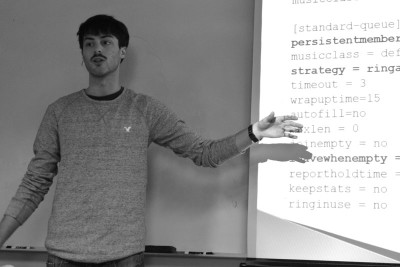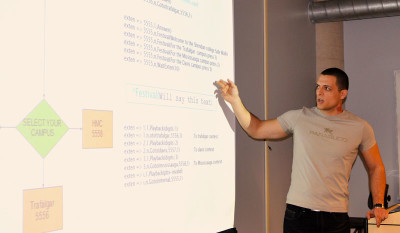Students look to improve Safe Walk
STORY AND PHOTOS BY MEHREEN SHAHID
They lurk behind the wires, they make networks run, they create connections that last, and they bring together people across a complex grid.
They are students in the Internet Communications Technology (ICT) program. William Farkas, coordinator for ICT, says the program focuses on the technologies and rules that make the Internet possible and emphasizes learning by hands-on training.
As part of their winter semester projects, a group of students in ICT decided to address an issue that has been breaking news for the last few months: sex assaults around campus and the subsequent implementation of the Safe Walk program.
“We wanted to keep it [the project] something that we would see as students at our college,” said Patrick Orlando, 21, a third-year student.
Orlando and his group decided to reshape the Safe Walk program by cutting short the process and time for a student to call for a volunteer.
Orlando’s colleague Keel Morgan explains that their aim is to streamline the available Safe Walk volunteers.
“We’re not trying to bring anything new except for connectivity. And it’s a process already in place, and we want to save time because time is money.”
Morgan elaborated on their project during a final class presentation. He says once the connectivity tool is in place, they’re using, Asterisk, is open source program, it can be tied in to the Sheridan network.
His friend, Cosmin Popescu, 24, says the system would be easy to implement since the basic structure already exists.
“If we want to implement this at Sheridan we will need four teams—security desk, HR, IT and our team. You would probably need just one day. We already have all the code we need.”
Popescu says HR will vet out volunteers for the Safe Walk program. This will help determine who among the volunteers has experience working with people with disabilities and first-aid training. He explains it is necessary to do so, because the system will provide four walker options: male with or without experience with handling disabilities and female with or without experience with handling disabilities.
Morgan explained that these volunteers will have a unique ID and a password. The moment they’re on one of the campuses, they will log on to the system using the ID and password and be placed in a continuous queue.
This means they will remain logged in just as students these days remain logged on to several social media apps simultaneously.
The fourth group member Munib Kaddafo, 32, explained that students will be given a number to call, for instance, 5555, after answering a short series of automated questions: the campus the student is calling from, the preferred gender of the volunteer and whether the caller is a person with disability. Then they will be connected to the first volunteer in the queue.
If the first volunteer fitting the required characteristics does not answer, the call will then automatically be directed to the next person in queue. Once a volunteer answers a call, he/she automatically goes back to the end of the queue until voluntarily logged out at the end of the day.
To demonstrate, the group set up Safe Walk volunteers in their class. One by one they showed how calls will be put through to the four categories of volunteers, each call taking only 30 seconds to reach the volunteer.
“In the beginning it was a lot of trial and error,” said Kaddafo.
Although they haven’t prepared a business plan, he says implementing this system wouldn’t be expensive.
“This isn’t as heavy duty a project as the one they will be required to do next semester, but I certainly think it could work. They have the technology right,” says Farkas.
Even though, according to Farkas, the students weren’t required to spend more than eight hours on this project, Orlando says most of their studies are high intensity, and they invest more than 14 hours on campus most days. The loss of all personal and social time eventually pays off big once they graduate.
Alumnus Brent Thomas, 34, who graduated a decade ago, says he started out with an annual average salary between $40k to $50k. Now he is earning six figures, has travelled around the world and has worked for several prestigious corporations.
Fellow alumnus Ryan Wilson, 33, senior systems engineer for MacAfee, says like others he was offered a job during his co-op time. Like Thomas, he is now earning in the six figures.
Farkas says ICT graduates have a 100 per cent employment rate. The program has always been small, as there are only 18 third-year students, but it has done well despite that.
Felix Carapaica, full-time faculty in ICT, has worked at Sheridan for 15 years and says what makes the students special is “the ability that they have to find solutions to problems. Years ago, a problem that will take you a long time to solve, now it is almost [second] nature for them to find solutions and adapt them.”
Farkas says it would be interesting to place a value on what the graduates of ICT do. Some graduates have excelled, in a short time, because they are qualified, and they are used to the hard work ethics that the program has instilled in them.
“They don’t receive flashy awards, but they just do their work quietly behind wires. They are only noticed when thing break down.”






